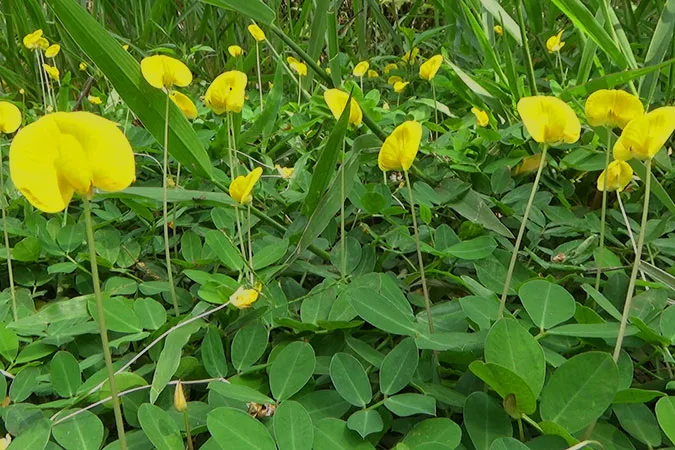Kacang hias or pinto peanut (Arachis pintoi) are plant species in Fabaceae that grow above the surface of the land, lowlands and highlands in the tropics, very adaptive but prefer to live in the shade rather than being exposed to direct sunlight.
A. pintoi is an annual herb, the stems grow to form a sturdy plait, the roots will grow from the stem if it has direct contact with the soil, has the ability to tether nitrogen from the air and is very well grown as ground cover, fodder, ornamental plants in urban areas and reduce erosion.
Pinto peanut has two pairs of leaves on each stalk, oval shaped for 1.5 cm wide and 3 cm long, producing continuous flowers throughout life for 40-65 flowers per square meter every day. Pollination will push the ovary in the gynophore to extend up to 27 cm and enter the ground up to 7 cm to form a pod that usually contains a seed.
A. pintoi grows and develops well in sub-tropical and tropical regions, annual rainfall is above 1,000 mm and 3-4 months strong dry but it will shed many leaves. Growth will be stunted and the leaves turn yellow if lacking water, frequent flooding and high salt levels.
This plant likes heavy clay to sandy, but grows better on sandy loam. It has a good adaptation to low soil fertility, a very acidic pH and tolerant of high aluminum saturation. Peanut pinto is propagated using seeds, cuttings and stolons.
This plant is often used as erosion control, land rehabilitation, weed control, nematode control including Meloidogyne arabicide and Meloidogyne exigua, to feed cattle, horses, donkeys, sheep, goats, pigs and chickens. The leaves contain high levels of protein and are good for digestion.
Kingdom: Plantae
Phylum: Tracheophyta
Subphylum: Angiospermae
Class: Magnoliopsida
Order: Fabales
Family: Fabaceae
Subfamily: Faboideae
Tribe: Dalbergieae
Genus: Arachis
Species: Arachis pintoi
A. pintoi is an annual herb, the stems grow to form a sturdy plait, the roots will grow from the stem if it has direct contact with the soil, has the ability to tether nitrogen from the air and is very well grown as ground cover, fodder, ornamental plants in urban areas and reduce erosion.
Pinto peanut has two pairs of leaves on each stalk, oval shaped for 1.5 cm wide and 3 cm long, producing continuous flowers throughout life for 40-65 flowers per square meter every day. Pollination will push the ovary in the gynophore to extend up to 27 cm and enter the ground up to 7 cm to form a pod that usually contains a seed.
A. pintoi grows and develops well in sub-tropical and tropical regions, annual rainfall is above 1,000 mm and 3-4 months strong dry but it will shed many leaves. Growth will be stunted and the leaves turn yellow if lacking water, frequent flooding and high salt levels.
This plant likes heavy clay to sandy, but grows better on sandy loam. It has a good adaptation to low soil fertility, a very acidic pH and tolerant of high aluminum saturation. Peanut pinto is propagated using seeds, cuttings and stolons.
This plant is often used as erosion control, land rehabilitation, weed control, nematode control including Meloidogyne arabicide and Meloidogyne exigua, to feed cattle, horses, donkeys, sheep, goats, pigs and chickens. The leaves contain high levels of protein and are good for digestion.
Kingdom: Plantae
Phylum: Tracheophyta
Subphylum: Angiospermae
Class: Magnoliopsida
Order: Fabales
Family: Fabaceae
Subfamily: Faboideae
Tribe: Dalbergieae
Genus: Arachis
Species: Arachis pintoi
